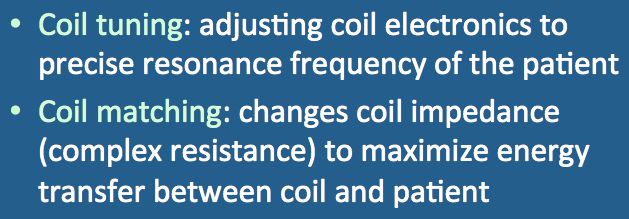When a patient is placed in the bore of a scanner, the magnetic field becomes distorted due to susceptibility effects. These produce small but significant changes in the magnetic field and Larmor frequencies within the patient. For optimal performance the electronic characteristics of the coil should be adjusted to precisely the patient-specific resonance frequency.
Because patients vary widely in size and shape, each person changes the impedance (electronic loading) of the transmit/receive coils slightly. For optimal energy transfer between the coil and the patient (in both directions) the impedance of the RF-coil must be matched to the impedance of the transmission line (i.e,, the wires connecting the RF-amplifier and the coil). If impedance matching is not done, a large fraction of the RF power generated by the amplifier will not be transmitted into the patient as it should be, but will be reflected back at the coil-transmission line interface. To insure a good match and efficient RF power transfer, the scanner circuitry monitors the ratio of forward-to-reflected RF power while capacitance is adjusted electronically at the coil-transmission line interface. When an impedance match is obtained, the reflected RF power is minimized.
Thirty years ago when I first began my career in MRI, coil tuning and matching was a manual process. The technologist had to walk to the back of the scanner and adjust the coils by turning knobs or flipping switches while watching the reflected RF power indicated by lights (Diasonics) or meter (Picker). On modern scanners the process is entirely automated. Failure to properly tune and match the coil may result in noisy images with poor contrast.
Advanced Discussion (show/hide)»
No supplementary material yet. Check back soon.
References
"Impedence Matching." Wikipedia, The Free Encyclopedia.
Stiles J. Impedence matching and tuning. Lecture Notes for EECS723 (Microwave Engineering), University of Kansas, 2009, available at this link.
"Impedence Matching." Wikipedia, The Free Encyclopedia.
Stiles J. Impedence matching and tuning. Lecture Notes for EECS723 (Microwave Engineering), University of Kansas, 2009, available at this link.
Related Questions
What is the scanner doing during the automatic pre-scan period?
What is the scanner doing during the automatic pre-scan period?
